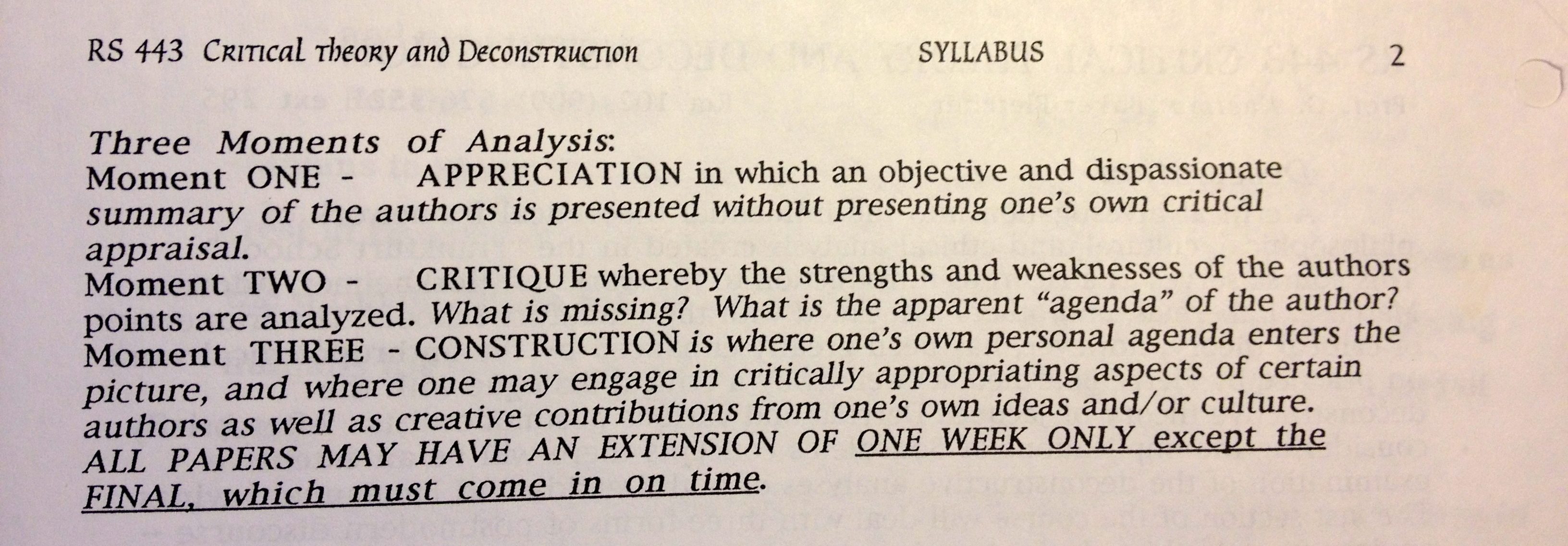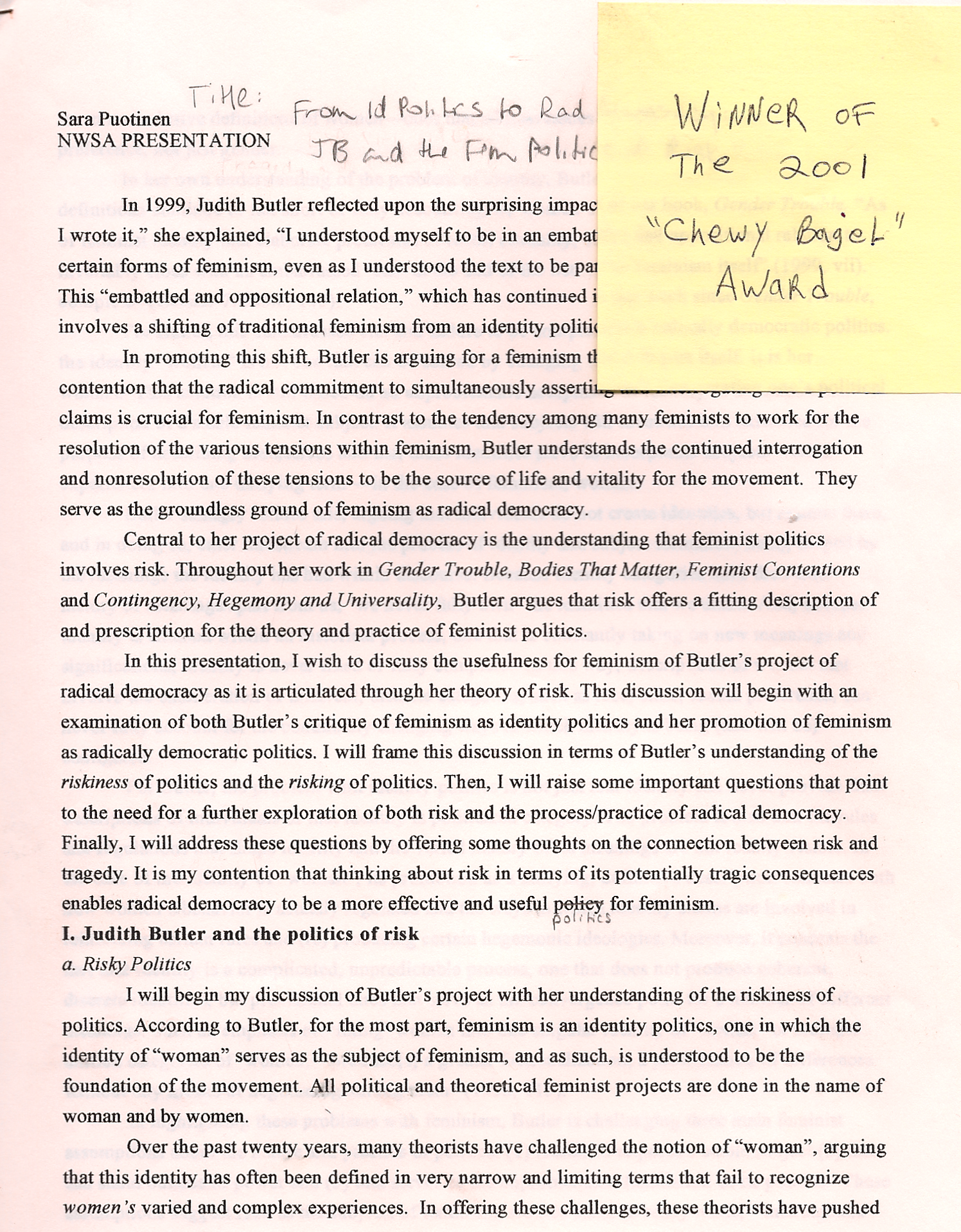This account is the first one that I wrote when I began diligently working on my intellectual history in early January 2013. I originally posted parts of it on TROUBLE. That’s where my sister read it and then texted me to let me know that my account wasn’t quite right. I corrected it and incorporated in some more thoughts about my memory fail.
Documents: Student Paper/Disrupting the Reader and Chewy Bagel Award Winner/NWSA Presentation
Pithy
In the margins of a blue book exam on social theory and ethics, one of four qualifying exams I completed for my masters in theological studies, my professor remarked favorably on my pithiness. I must admit, I had to look that word up. It was the first time I recall encountering it. When I found the definition, probably located in my trusty, beat-up Webster’s dictionary that I had used a lot in college, I was pleased.
pithy: having substance and point: tersely cogent. syn see CONCISE
Terse and concise? Yep, that’s how I write.
Up to that point, I had seen my economy of words and my ability to densely pack my prose with the key ideas as a liability; it often made it incredibly difficult to meet the minimum page requirements for final papers in my graduate classes. Other grad students bemoaned the maximum page requirement by complaining, “how am I supposed to fit my endless number of brilliant ideas into a mere 25 pages?!” I’m kidding…mostly. But I feared the dreaded page minimum as I won- dered, “how will I possibly manage to fill up 15 pages?!” (note: my doctoral dissertation was only 165 pages).
My papers were successful and given positive feedback from professors, but I kept feeling as if I was failing as a grad student and an academic-in-training. How could everyone else write so much and me so little?
As I read these lines, my cynicism begins to surface: Perhaps my pithiness was a sign of failing as an academic? Brief and concise (and clear) writing is often misread in the academy as a lack of intellectual rigor, where a longer paper = deeper thinking. Is there room to be a different sort of academic or intellectual?
So, when I read my professor’s positive description of my work as pithy, I was relieved. Being concise and brief was not necessarily a bad thing! This might seem like an obvious point, but if you’ve read much academic writing you know that brevity is unusual.
Logical. Efficient. Precise.
As an academic-in-training, my writing style was very logical and highly ana- lytical, perhaps boringly so. I remember a favorite professor at my college (Gusta- vus Adolphus College in St. Peter, MN) frequently praised my analytical ability.
[Sara — Excellent work. I repeat, you take to this sort of analysis with such apparent ease that the work seems natural for you. Your writing is simple, succinct, properly unornamented and to the point.]
I also recall him remarking on one occasion, “Don’t take this the wrong way, but when I read your writing, I don’t feel like I’m reading a paper written by a woman.” Am I remembering that right? And what does it exactly mean? I’m not quite sure. What I do remember was that, in spite of his blind spots, he was a great teacher who introduced me to a lot of wonderful scholarship on religion, Cornel West and how to be a public intellectual.
When I wrote a paper, I spent a lot of time figuring out the logic of my argument. I didn’t just write; I mapped out ideas and created endless index cards with my three (always three!) main points. I ruthlessly cut out extraneous information (and words) that did not fit with my thesis and goals for my paper. Logical. Efficient. Precise. Pithy.
My love of pith (and the magic number 3), which was cultivated as an undergrad in philosophy and religion courses, was furthered fostered in the many masters’ classes that I took with Dr. Garth Kasimu Baker-Fletcher. Borrowing from one of his professors at Harvard University, he required that we write our papers (2 twenty pagers + 1 twenty-five page final) using a three (!) part structure: 1. appreciation, 2. critique and 3. construction.
Of course, with my love of clear, logical writing and things-in-threes, I eagerly embraced his method. And I used it to structure my writing efficiently: 4-5 pages on appreciation; 6 pages on critique; 4-5 pages on construction. I continued to apply it to my writing for years, and when I started teaching, I used it for developing my courses and structuring some of my critical thinking assignments. The logical progression from understanding to critiquing to applying seemed to work well as a model for learning over the course of a semester.
But, even as I continued to be pithy, I was being introduced to theories that challenged and questioned the value of clear and concise writing. In the first class that I took with GK Baker-Fletcher in the fall of 1996, Critical Theory and Deconstruction, I was introduced to Jacques Derrida. A semester later, in my Contemporary Feminist Theory course, I read Luce Irigaray and Judith Butler. Each of these authors argue for the need to challenge language and grammar as innocent and merely descriptive, contending that we must look for the blind spots in the text, where hidden and alternative meanings exist, but are ignored or concealed.
I became intrigued with writing styles that challenged readers and playfully unsettled ideas and theories. I wrote papers on disrupting readers, challenging common sense and safeguarding critical thinking. I argued that difficult writers were not merely aiming to piss off their readers. Instead, they were attempting to involve readers in the process of reading, interpreting and rethinking. And, because their work was focused on making visible and disrupting the limits of language, they were attempting to demonstrate those limits through their own writing practices.
There seemed to be a contradiction between my own pithy style and the confusing and disruptive style of Irigaray, who quoted key Western thinkers like Freud or Descartes and playfully inserted her own critical interjections directly into the quotations, and Butler, who peppered her prose with tons of questions and wrote epic, page-long paragraphs, loaded with complexity and implicit references to countless philosophers/thinkers. Even as I loved writing about these thinkers (especially Butler and Irigaray), I didn’t love writing like them. My style remained pithy and clear.
But, slowly and gradually, as I studied more critical theories that challenged claims for clarity, common sense and singular narratives/reading and as I became more immersed in feminist challenges to theorizing in the academy as a Ph.D student at Emory University, my writing style began to shift. Or, at least my understanding of it did. My purpose in writing was no longer simply to clearly explain (or report/summarize) an author’s ideas, raise a few critical questions to those ideas and then tentatively provide my own proposals for future work. Instead, it was about crafting sentences that packed a punch, that pushed the reader to think and question and that required me (as the writer) to devote a lot of attention to processing and reflecting on the ideas and theories that I was writing about. My writing was becoming increasingly dense and packed with ideas, questions and provocations. It was no longer pithy, it was chewy.
Chewy
In 2001, I presented at the National Women’s Studies Conference in Minneapolis. Before attending the conference, my dad agreed to read it. My dad was always awesomely supportive of my academic work. Other than my committee, he might the only person that read my dissertation. When he returned it to me, he declared that it was the winner of the 2001 Chewy Bagel Award. Thinking that this chewy bagel description was “a brilliant assessment of most academic writ- ing,” my brother-in-law, wrote it on a post-it note and placed it on the front of my paper.
When I first crafted this account and posted it on my blog, I mistakenly wrote that my dad had written the post-it note. My sister texted to let me know that it was actually her husband that had written it and placed it on my paper. I’m grateful that she reads my work and was willing to correct me. I appreciate having a more reliable account of this event, one that enables me to move be- yond my typical approach to remembering events as only happening to me or between me and one other person.
I loved that my dad declared that my presentation was a Chewy Bagel! I can’t remember exactly what he said as an explanation for his award, but his idea that my work was “chewy” stuck with me. After earning my Ph.D and starting to teach and research at the University of Minnesota in 2006, I embraced my chewiness. I often told my students the story about my dad and talked about the importance of writing chewy papers. And, when we encountered a particularly challenging text (like one by Judith Butler or Jasbir Puar), I often opened our class discussion with, “Wow, that was a chewy bagel!”
Chewy writing is dense and requires that both the writer and the reader devote substantial time to thinking through the ideas, theories or experiences that are being written about. Unlike some pithy writing, which is aimed at getting to the point quickly and efficiently so that the reader can easily digest the ideas, chewy writing is aimed at encouraging (or forcing) the reader to stop and engage in slow and careful rumination (chewing) on ideas, words, and claims. Here is what Butler says in “What is Critique: An Essay on Foucault’s Virtue” about the need for chewiness and how it enables us to patiently and persistently think and reflect:
But here I would ask for your patience since it turns out that critique is a practice that requires a certain amount of patience in the same way that reading, according to Nietzsche, required that we act a bit more like cows than humans and learn the art of slow rumination (307).
A dense, chewy bagel cannot easily be consumed. It requires effort to be eaten. A chewy bagel text is the same way. It is not meant to be easily understood or digested. It demands that we devote some serious time and effort to engaging and processing the ideas that it presents.
Pithy Chewiness
I love writing chewy bagels. Essays that are packed with ideas that aren’t always readily understood. Ideas that trouble us. Make us wonder. Make us challenge our own common-sense assumptions. But, as my kids get older (they’re now 9.5 and 6.5) and they demand more mental attention, I’ve started to question the form that a chewy bagel usually takes, as an academic essay or a ridiculously long blog entry. Not many people that I encounter on a regular basis have the time to or interest in “chewing” on 1000-3000 words on feminist or queer theory. So, in the past year, I’ve started to experiment with various ways in which to present problems or raise questions that encourage people to think (and chew) without requiring that they read a lot of words. I guess I’m hoping to be chewy in my pithiness or pithy in my chewiness.


